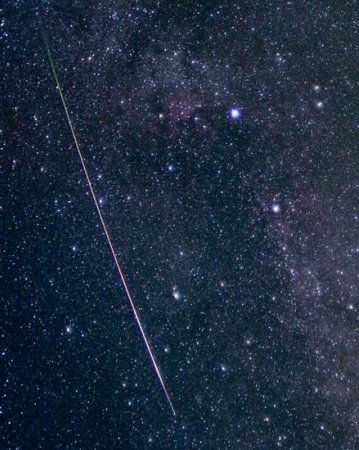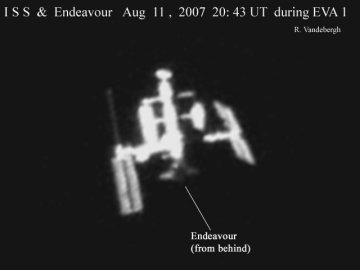 Where's Saturn? Is that a UFO--or the ISS? What's the name of that star? Get the answers from mySKY--a fun new astronomy helper from Meade. Where's Saturn? Is that a UFO--or the ISS? What's the name of that star? Get the answers from mySKY--a fun new astronomy helper from Meade. METEOR NIGHT: The Perseid meteor shower peaks tonight. No matter where you live, the show begins on Sunday, Aug. 12th, around 10 pm local time when the constellation Perseus rises in the northeast. Expect to see a meteor every five minutes. The rate will surge as the night unfolds, increasing to one or two meteors per minute before dawn on Monday, Aug. 13th. "Here is my first Perseid of the season, and what a nice one it was too," says Pete Lawrence of Selsey, UK, who snapped this picture on August 12th: 
"The trail appears slightly curved due to edge distortion in the lens," he adds. 2007 Perseid Meteor Gallery
[observing tips] [sky map] SPACESHIP SIGHTING: Earlier today, while spacewalking astronauts from shuttle Endeavour added a new truss to the International Space Station (ISS), the two spacecraft flew high over the Netherlands. Ralf Vandebergh was ready with his 10-inch backyard telescope and a digital camera, and he took this picture: 
"We clearly see the backside and wings of the shuttle docked to the much larger space station," says Vandebergh. "Here is another image from a slightly different perspective." The ISS and Endeavour will continue flying over Europe through the next week, making many bright and favorable evening passes. Europeans, get your flyby predictions from Heavens Above.
.2007 Noctilucent Cloud Gallery
[Night-Sky Cameras] ["Noctilucent Cloud"--the song] | 
